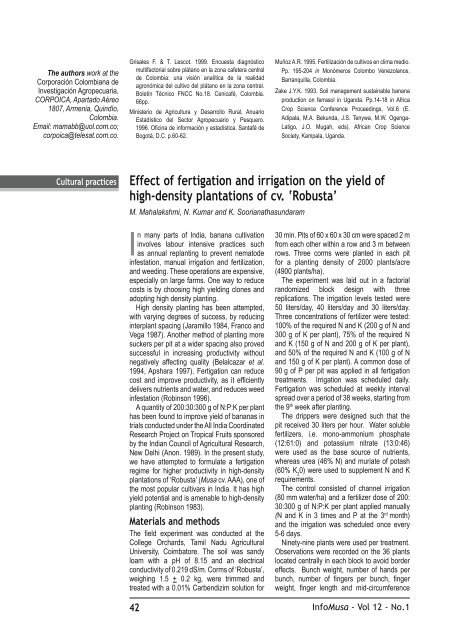Château-Musa - Bioversity International
Château-Musa - Bioversity International
Château-Musa - Bioversity International
You also want an ePaper? Increase the reach of your titles
YUMPU automatically turns print PDFs into web optimized ePapers that Google loves.
The authors work at the<br />
Corporación Colombiana de<br />
Investigación Agropecuaria,<br />
CORPOICA, Apartado Aéreo<br />
1807, Armenia, Quindío,<br />
Colombia.<br />
Email: mamabb@uol.com.co;<br />
corpoica@telesat.com.co.<br />
Cultural practices<br />
Grisales F. & T. Lescot. 1999. Encuesta diagnóstico<br />
multifactorial sobre plátano en la zona cafetera central<br />
de Colombia: una visión analítica de la realidad<br />
agronómica del cultivo del plátano en la zona central.<br />
Boletín Técnico FNCC No.18. Cenicafé, Colombia.<br />
66pp.<br />
Ministerio de Agricultura y Desarrollo Rural, Anuario<br />
Estadístico del Sector Agropecuario y Pesquero.<br />
1996. Oficina de información y estadística. Santafé de<br />
Bogotá, D.C. p.60-62.<br />
Effect of fertigation and irrigation on the yield of<br />
high-density plantations of cv. ‘Robusta’<br />
M. Mahalakshmi, N. Kumar and K. Soorianathasundaram<br />
In many parts of India, banana cultivation<br />
involves labour intensive practices such<br />
as annual replanting to prevent nematode<br />
infestation, manual irrigation and fertilization,<br />
and weeding. These operations are expensive,<br />
especially on large farms. One way to reduce<br />
costs is by choosing high yielding clones and<br />
adopting high density planting.<br />
High density planting has been attempted,<br />
with varying degrees of success, by reducing<br />
interplant spacing (Jaramillo 1984, Franco and<br />
Vega 1987). Another method of planting more<br />
suckers per pit at a wider spacing also proved<br />
successful in increasing productivity without<br />
negatively affecting quality (Belalcazar et al.<br />
1994, Apshara 1997). Fertigation can reduce<br />
cost and improve productivity, as it efficiently<br />
delivers nutrients and water, and reduces weed<br />
infestation (Robinson 1996).<br />
A quantity of 200:30:300 g of N:P:K per plant<br />
has been found to improve yield of bananas in<br />
trials conducted under the All India Coordinated<br />
Research Project on Tropical Fruits sponsored<br />
by the Indian Council of Agricultural Research,<br />
New Delhi (Anon. 1989). In the present study,<br />
we have attempted to formulate a fertigation<br />
regime for higher productivity in high-density<br />
plantations of ‘Robusta’ (<strong>Musa</strong> cv. AAA), one of<br />
the most popular cultivars in India. It has high<br />
yield potential and is amenable to high-density<br />
planting (Robinson 1983).<br />
Materials and methods<br />
The field experiment was conducted at the<br />
College Orchards, Tamil Nadu Agricultural<br />
University, Coimbatore. The soil was sandy<br />
loam with a pH of 8.15 and an electrical<br />
conductivity of 0.219 dS/m. Corms of ‘Robusta’,<br />
weighing 1.5 + 0.2 kg, were trimmed and<br />
treated with a 0.01% Carbendizim solution for<br />
42<br />
Muñoz A.R. 1995. Fertilización de cultivos en clima medio.<br />
Pp. 195-204 in Monómeros Colombo Venezolanos.<br />
Barranquilla, Colombia.<br />
Zake J.Y.K. 1993. Soil management sustainable banana<br />
production on ferrasol in Uganda. Pp.14-18 in Africa<br />
Crop Science Conference Proceedings, Vol.6 (E.<br />
Adipala, M.A. Bekunda, J.S. Tenywa, M.W. Ogenga-<br />
Latigo, J.O. Mugah, eds). African Crop Science<br />
Society, Kampala, Uganda.<br />
30 min. Pits of 60 x 60 x 30 cm were spaced 2 m<br />
from each other within a row and 3 m between<br />
rows. Three corms were planted in each pit<br />
for a planting density of 2000 plants/acre<br />
(4900 plants/ha).<br />
The experiment was laid out in a factorial<br />
randomized block design with three<br />
replications. The irrigation levels tested were<br />
50 liters/day, 40 liters/day and 30 liters/day.<br />
Three concentrations of fertilizer were tested:<br />
100% of the required N and K (200 g of N and<br />
300 g of K per plant), 75% of the required N<br />
and K (150 g of N and 200 g of K per plant),<br />
and 50% of the required N and K (100 g of N<br />
and 150 g of K per plant). A common dose of<br />
90 g of P per pit was applied in all fertigation<br />
treatments. Irrigation was scheduled daily.<br />
Fertigation was scheduled at weekly interval<br />
spread over a period of 38 weeks, starting from<br />
the 9 th week after planting.<br />
The drippers were designed such that the<br />
pit received 30 liters per hour. Water soluble<br />
fertilizers, i.e. mono-ammonium phosphate<br />
(12:61:0) and potassium nitrate (13:0:46)<br />
were used as the base source of nutrients,<br />
whereas urea (46% N) and muriate of potash<br />
(60% K 2 0) were used to supplement N and K<br />
requirements.<br />
The control consisted of channel irrigation<br />
(80 mm water/ha) and a fertilizer dose of 200:<br />
30:300 g of N:P:K per plant applied manually<br />
(N and K in 3 times and P at the 3 rd month)<br />
and the irrigation was scheduled once every<br />
5-6 days.<br />
Ninety-nine plants were used per treatment.<br />
Observations were recorded on the 36 plants<br />
located centrally in each block to avoid border<br />
effects. Bunch weight, number of hands per<br />
bunch, number of fingers per bunch, finger<br />
weight, finger length and mid-circumference<br />
Info<strong>Musa</strong> - Vol 12 - No.1

















